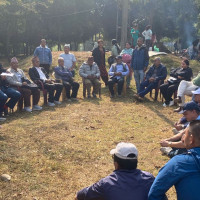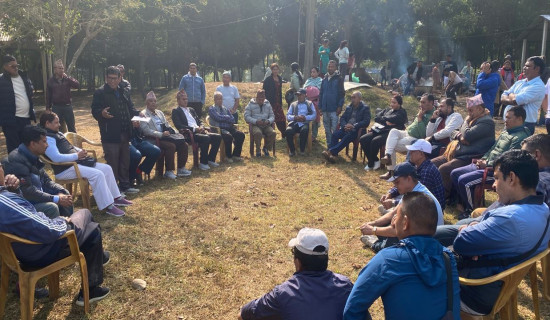- Thursday, 27 November 2025
Gen Z Movement: Outburst Of Civic Fury
Nepal’s Gen Z movement has accomplished a powerful political construction in the country. It has introduced a new political narrative confirming that civic power is invincible regardless of the ferocity and enormity of state power. In fact, the Gen Z movement has become a kind of recourse for youths not only in Nepal but across the world to vent their ire against the maladministration and unemployment. The youth rebellion in Mexico is the latest upsurge in a series of agitations spreading in different countries across the world.
In Nepal’s case, the movement was a kind of miracle because it had unexpectedly uprooted the regime of the parties whose leaders ruled the country without delivering befitting their promises and commitments expressed time and again. It sent strong signals that corruption and misrule, which have been rampant in all walks of life, could be resisted by the disenchanted young citizens with all their might. Though the new interim government, headed by Sushila Karki, is allegedly ineffective in addressing the aspirations of the Gen Z youths, it has established that state power is needed to take into account the popular wishes and aspirations to stay on course and prove legitimacy in the eyes of the people.
Straw hat with crossbones
Nepali Gen Z youths, to whom the current resistance and rebellion against the coalition government led by KP Oli is attributed, are said to have used a popular flag flaunting “a straw hat with crossbones behind it” as a popular symbol. It fluttered in Maitighar Mandala but not very frequently. The straw hat emblem is tied to themes of freedom, resisting oppression and protecting the weak. This imagery, according to Wikipedia, has been repurposed by real-world protesters as a visible and ready symbol of dissent. This easily recognised pop culture flag, according to media reports, was first used in Indonesia to express shared grievances and frustration among different sections of the working class.
Reports say that the Indonesian authorities attempted to ban or confiscate the flag. Its result was that the flag as a symbol of protest became more potent and its use became more widespread in Indonesia and consequently spread to other countries, including Nepal. The symbol worked as a simple and nonviolent badge of discontent and frustration among the people. Youths in Nepal protested against a sweeping social media ban. The flag, according to reports, featured as a unifying emblem for Gen Z demonstrators. However, the flag was not used in a widespread manner in Bangladesh or Sri Lanka. But the protests in those countries had also spiraled to reflect broader discontent among the people, as a result of which the government had collapsed and the ruling political leaders had to flee the country.
Many young people in Nepal had been infuriated and enraged for a long time for reason of the fact that the children of political leaders — so-called Nepo kids — seem to enjoy luxurious lifestyles and numerous advantages while most youths struggle to find work and gainful employment. With youth unemployment running at about 20 per cent last year, according to the World Bank, the government estimates that around 2,000 young people leave the country every day to seek work in the Middle East or Southeast Asia, especially Malaysia.
Youths in Nepal today, like in other countries, are skillfully conversant with digital technology and the use of social media has become a way of life for them. Information and communication technology has become a source of income generation for many youths in the country. The government's move to restrict popular social media had given rise to massive discontent. The use of digital technology and the spread of social media have significantly transformed the mode and modality of political mobilisation and altered the dynamics of civic protests, which was evident in the Gen Z-led agitation.
Despite the restrictive measures enforced by the government, protestors managed to make use of social media. These provided avenues for youths to mobilise, organise, and increase political mobilisation and engagement. They facilitated decentralised organisation and the swift dissemination of information across spaces. Social media platforms facilitated the rapid and effective organisation of protest movements and amplified marginalized voices. Social media enabled youth movements to coordinate efforts and share their messages on a larger scale.
However, the influence of social media on politics, according to experts, is not always positive. While it has fostered greater civic participation, it contributes to the spread of misinformation and disinformation, potentially fuelling distrust in democratic institutions. Phenomena such as clicktivism, as forms of low-effort digital activism, oversimplify complex issues and lead to a false sense of accomplishment without tangible results.
Destruction of properties
Nepal’s Gen Z agitation - a short-lived happenstance lasting for two days only – can be critiqued because it resulted in not only the killing of young people but also destroyed the physical assets, surpassing all records. The national monuments like Singha Durbar, Supreme Court and parliament buildings, local government physical infrastructures and private business firms and complexes have been set ablaze and burnt down mercilessly beyond repair and restoration. Moreover, the private residents have been attacked and reduced to the ground.
Was it the result of the sudden outburst of the rage of the Gen Z youths or the planned conspiracy of the anti-state forces bent upon wrecking and destabilizing in the country, is yet to be investigated. The Karki-led interim government is expected to probe into the causes and consequences of the large-scale destruction effectively, apart from pinpointing the responsibility for the ruthless killings of the youths.
(The author is presently associated with Policy Research Institute (PRI) as a senior research fellow. rijalmukti@gmail.com)














